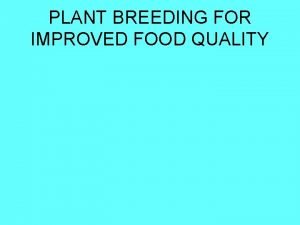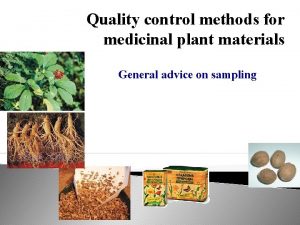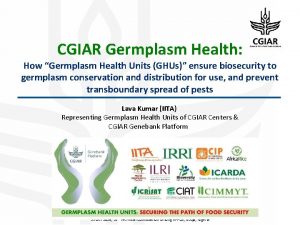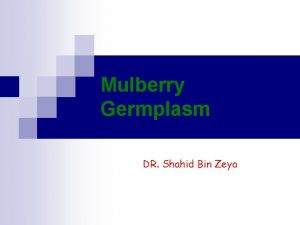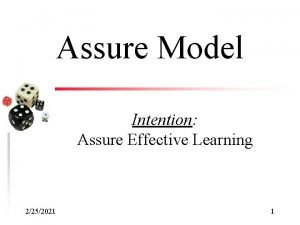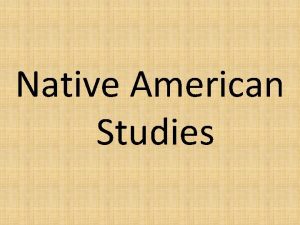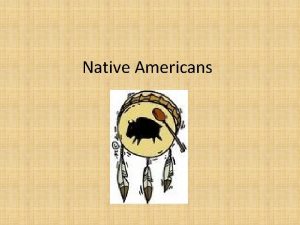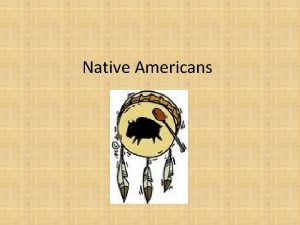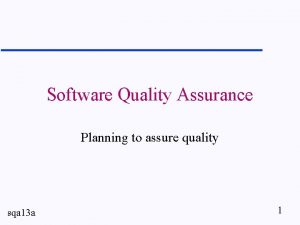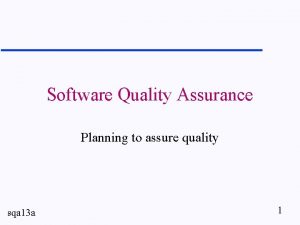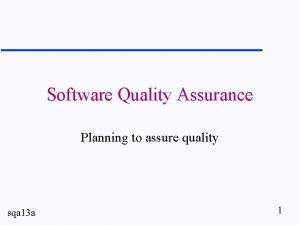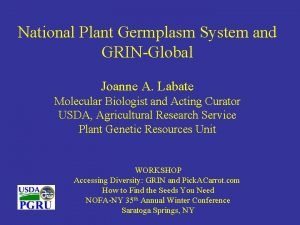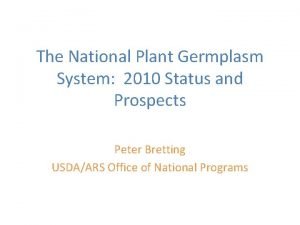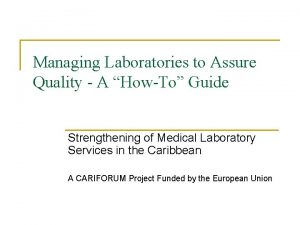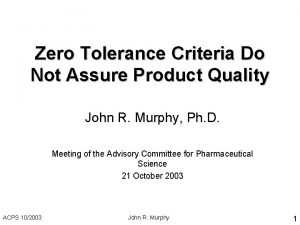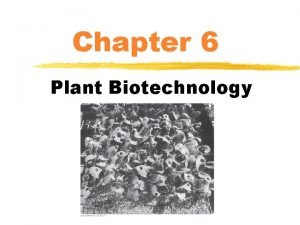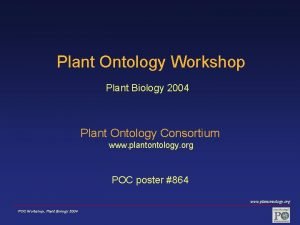Assure the Quality of Native Germplasm through PLANT




































- Slides: 36

Assure the Quality of Native Germplasm through. . .

PLANT GERMPLASM RELEASE AND CERTIFICATION PROCEDURES ESTABLISHED BY THE ASSOCIATION OF OFFICIAL SEED CERTIFYING AGENCIES (AOSCA)

TRADITIONAL APPROACH of Plant Germplasm Release To The Public • CULTIVAR RELEASE--Broad based, widely adapted cultivars with outstanding and/or unique characteristics with stable heritability • GERMPLASM RELEASE -- Minimally developed plant material possessing desirable traits released for use in breeding programs

Reclamation and Restoration Professionals indicate - • Increasing need for local ecotypes • Superior or unique characteristics are no longer only factors considered • Desire for minimal or no genetic manipulation • Need to insure source and genetic purity for harvested/collected materials

Justification for Pre-Variety Release and Certification Procedures • Propagation material of natural ecotypes are needed for ecosystem restoration • Inadequate seed sources for species or desired ecotypes • Time frame precludes traditional cultivar development • Limited potential market beyond applicable plant communities

Genetic Status of Plant Populations Manipulated • Purposeful genetic manipulation (recurrent selection, hybridization, mutations, synthetic combinations, genetic engineering, etc. ) has occurred • Genetic variability of defined plant population has been expanded or narrowed Natural • No genetic manipulation of the original accession occurred • Full genetic variability of defined ecotype is maintained

Germplasm Source and Identity Manipulated • • • Native, naturalized, or exotic germplasm Origin and genetic status of germplasm accession often not known Detailed records of parental lines and genetic manipulation procedures required Natural • Native, naturalized, or exotic germplasm; may be a narrow germplasm accession or broad ecotype collection • Location and characteristics of original collection site documented • Protocols established to minimize involuntary non-purposeful selection during collection, site testing, or reproduction in the field

Germplasm Development and Potential Release Categories Germplasm Accession or Ecotype Collection Manipulated 1. (Bulk Populations)* 2. Selected Class 3. Tested Class 4. Cultivar/Variety *development category only Natural 1. 2. 3. 4. Source Identified Class Selected Class Tested Class Cultivar/Variety

Germplasm Release Procedure I Manipulated Natural Bulk Populations No Tag Source Identified Class Yellow Tag; G 1, G 2, G 3 • Unique characteristics not identified • Comparisons with other accessions, ecotypes, or bulk populations unknown • Area of adaptation unknown

Germplasm Release Procedure I cont’d Manipulated Bulk Populations No Tag • • • Research and development stage No selection or testing of F 1’s Occasionally released to other breeders • Not released to public for reproduction Natural Source Identified Class Yellow Tag; G 1, G 2, G 3* • Random germplasm accessions • No selection or testing of natural population • Status of majority of wild collected certified seed; may also be field produced * Generations if planted in field production; a natural stand is by definition G 0.

Germplasm Release Procedure II Manipulated Natural SELECTED CLASS Green tag; G 1, G 2, G 3 • Requires comparisons with other accessions, ecotypes, or breeding lines at common sites. • Shows promise of superior and/or unique traits. • Preliminary data on area of adaptation as defined by test conditions.

Germplasm Release Procedure II cont’d Manipulated Natural SELECTED CLASS Green tag; G 1, G 2, G 3 • Early Generation breeding lines under evaluation • May be released to other breeders • Occasionally reproduced and tagged for public use • Germplasm accession selected from accession pool • May be tagged and marketed as wild collected or field produced seed • “Untested Seed Orchard” (pink tag) an accepted subset of Selected Class forest tree seed

Germplasm Release Procedure III Manipulated Natural TESTED CLASS Blue Tag; G 1, G 2, G 3 • Seed must be produced from rigidly controlled and isolated natural stands or seed fields • Progeny tested on several sites to demonstrate superior or unique traits for which heritability is stable • Area of adaptation more certain as defined by test site conditions

Germplasm Release Procedure III cont’d Manipulated Natural TESTED CLASS Blue Tag; G 1, G 2, G 3 • Advanced generation breeding lines • May be released to other breeders (traditional germplasm release) • Occasionally reproduced and tagged for public use • Germplasm accession progeny tested • Applied to individual forest trees or natural stands; may also be field produced • Tagged for public use where potential market is limited

Germplasm Release Procedure IV Manipulated CULTIVAR/VARIETY Foundation (G 1) White Tag Registered (G 2) Purple Tag Certified (G 3) Blue Tag Natural CULTIVAR/VARIETY Foundation (G 1) White Tag Registered (G 2) Purple Tag Certified (G 3) Blue Tag • Clearly distinguished by superior qualities or unique traits • Reproduction is stable and outstanding characters heritable • Naming must comply with federal and state seed law definitions • Broad-based, wide area of adaptation as determined by testing locations • Good market potential perceived

Germplasm Release Procedure IV cont’d Manipulated CULTIVAR/VARIETY Foundation (G 1) White Tag Registered (G 2) Purple Tag Certified (G 3) Blue Tag • Breeder seed (G 0) is defined and maintained by breeder of cultivar Natural CULTIVAR/VARIETY Foundation (G 1) White Tag Registered (G 2) Purple Tag Certified (G 3) Blue Tag • Original germplasm accession or seed collected from a defined ecotype or natural stand is defined as G 0 (equivalent to breeder seed).

Labeling, Protection, and Marketing of Certified Seed Cultivar/Variety • • Identified on tag by crop and cultivar (variety) name Has status of recognized variety under Federal and State seed law Eligible for protection under the Plant Variety Protection Act Only seed meeting certification requirements and properly tagged may be represented as certified seed

Labeling, Protection, and Marketing of Certified Seed Pre-Variety Release • Identified on tag by species name • Optional identification (number or descriptive designation) not to be construed as variety name • Tags for Natural germplasms must list geographic location of seed collection site or field production site • Not eligible for protection under the Plant Variety Protection Act • Only seed meeting certification requirements and properly tagged may be represented as certified seed

NRCS Planned Use of AOSCA Release Classes

NRCS Use of AOSCA Release Classes Class Natural Source Identified X 1 Selected Tested Cultivar/Variety X 1 X 1 Germplasm “traditional” Manipulated X 2 1) NRCS would, generally, use these release classes for “Natural” native species 2) NRCS would, generally, use these release classes for “Manipulated” native species and plants not native to North America

Source Identified • collected from natural stands, seed production areas, orchards • no selection or testing of parent population • collection site data is specified (i. e. soils, elevation, precip. , legal description etc. . ) • species literature review • documentation usually less than one year (generally not applicable to NRCS PM program) • no limitations on number of generations from natural stands

Uses for Source Identified include: • materials address high priority needs • high potential for immediate use • lack of commercially available adapted materials • a local source is available

Selected • species literature review • phenotypically selected plants of untested parentage with selections based on promise or observed superior performance • documentation, testing and release process may involve several years-i. e. 3 years or less • collected from natural stands, production areas or orchards • for field production, generations cannot exceed four and will be indicated as G 1, G 2, etc. . for generation one, generation two, etc. . • original collection site data (soils, elevation, precip. etc. . )

Uses for Selected materials include: • lack of or low availability of adapted commercial materials • commercial sources are not adapted/or have no proven performance to meet identified need • materials address high priority needs

Tested • species literature review • original collection site data • involves initial and advanced evaluations-usually at multiple locations • testing, documentation, and release processes can involve 36+ years • progeny whose parentage has been tested and has proven superior performance against other collections and/or cultivars-varieties, heritability of distinctive traits must be stable • for field production, generations are limited to four and indicated as G 1, G 2, etc.

Uses for Tested materials include: • materials address high priority needs • low numbers of commercially available adapted materials • proven performance and /or superior traits (vs. commercial materials) are needed

Cultivar / Variety • species literature review • original collection site data (soils, legal description elevation, etc. ) • documentation, testing, and release processes can require 6 -9+ years • selections are based on proven superior performance vs. other collections and/or cultivars-varieties, distinctive traits are heritable and stable

Cultivar cont’d. • involves replicated plantings at multiple locations • for field production, generations are < four and are indicated as breeder (B), foundation (F), registered (R), and certified (C) • range of adaptation and conservation value are determined through field plantings, trials, and demonstration plantings • use of plant breeding methods such as : Mass Selection, Recurrent Restricted Phenotypic Selection (RRPS), etc. will put this in the “manipulated” vs. “natural” release class

Uses for Cultivars/Varieties include: • materials address high priority needs • commercially adapted materials do not exhibit adequate performance within target area • materials are needed, but not available, which have proven performance and broad adaptation

Germplasm “traditional” • involves materials that have been genetically manipulated; if not, then materials can be released as source identified, selected, or tested • priority, the material was originally intended for, was reduced • has desirable characteristics but does not meet current NRCS priorities • has some limitation that NRCS does not wish to overcome • species literature review and original collection site data • material is intended for other researchers, not for commercial production • infrequent use in the USDA Plant Materials Program

USES for • SOURCE IDENTIFIED: the defined problem or use area is limited to a geographical area with environmental factors similar to the source • SELECTED: the defined problem or use area is generally broader geographically with limited variability in environmental factors • TESTED: the defined problem or use area is larger geographically, i. e. MLRA, with moderate variability in environmental factors

USES for • Cultivar/Variety: The defined problem or use area is usually large geographically, i. e. multistate, with potentially high variability in environmental factors

EXPECTED PERFORMANCE * Will Perform Probably Will Perform May Perform Insufficient Data Cultivar Source Identified Selected Tested Near/Similar Far/Dissimilar Distance from Source/ Environmental Conditions * graph is based on judgement & experience-NOT actual data

SUMMARY • Pre-Variety release procedures targeted to conservation plants • Intended to fill need for ecosystem restoration • Expedites use of plant material of assured genetic source and purity

Partners in Developing Pre-Variety Release and Certification Procedures Association of Official Seed Certifying Agencies (AOSCA) U. S. Forest Service Natural Resources Conservation Service Agricultural Research Service

Presented by USDA Natural Resources Conservation Service The USDA prohibits discrimination in its programs on the basis of race, color, national origin, sex, religion, age, disability, political beliefs and marital and familial status. (Not all prohibited bases apply to all programs). Persons with disabilities who require alternative means for communication of program information (braille, large print, audiotape, etc. ) should contact the USDA Office of Communications at (202) 720 -2791. To file a complaint, write the Secretary of Agriculture, U. S. Dept. of Agriculture, Washington, D. C. 20250, or call (202)720 -7327(voice) or (202) 720 -1127 (TDD). USDA is an equal employment opportunity employer.
 Intraspecific hybridization
Intraspecific hybridization Plant introduction in plant breeding
Plant introduction in plant breeding Plant introduction in plant breeding
Plant introduction in plant breeding Tronsmo plant pathology and plant diseases download
Tronsmo plant pathology and plant diseases download Tronsmo plant pathology and plant diseases download
Tronsmo plant pathology and plant diseases download Tronsmo plant pathology and plant diseases download
Tronsmo plant pathology and plant diseases download Explain plant breeding for improved food quality
Explain plant breeding for improved food quality Quality control methods for medicinal plant materials
Quality control methods for medicinal plant materials Quality assurance vs quality control
Quality assurance vs quality control Quality management pmp
Quality management pmp Pmp gold plating
Pmp gold plating Quality improvement vs quality assurance
Quality improvement vs quality assurance Quality improvement vs quality assurance
Quality improvement vs quality assurance Concepts of quality
Concepts of quality Quality management gurus
Quality management gurus Crosby quality is free
Crosby quality is free Old quality vs new quality
Old quality vs new quality Through one man
Through one man Classes of furcation
Classes of furcation Tangential sawing advantages and disadvantages
Tangential sawing advantages and disadvantages Who wrote the night of the scorpion
Who wrote the night of the scorpion Hát kết hợp bộ gõ cơ thể
Hát kết hợp bộ gõ cơ thể Frameset trong html5
Frameset trong html5 Bổ thể
Bổ thể Tỉ lệ cơ thể trẻ em
Tỉ lệ cơ thể trẻ em Gấu đi như thế nào
Gấu đi như thế nào Glasgow thang điểm
Glasgow thang điểm Chúa yêu trần thế alleluia
Chúa yêu trần thế alleluia Các môn thể thao bắt đầu bằng tiếng nhảy
Các môn thể thao bắt đầu bằng tiếng nhảy Thế nào là hệ số cao nhất
Thế nào là hệ số cao nhất Các châu lục và đại dương trên thế giới
Các châu lục và đại dương trên thế giới Cong thức tính động năng
Cong thức tính động năng Trời xanh đây là của chúng ta thể thơ
Trời xanh đây là của chúng ta thể thơ Mật thư anh em như thể tay chân
Mật thư anh em như thể tay chân Phép trừ bù
Phép trừ bù Phản ứng thế ankan
Phản ứng thế ankan Các châu lục và đại dương trên thế giới
Các châu lục và đại dương trên thế giới






